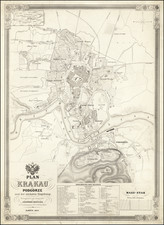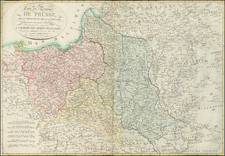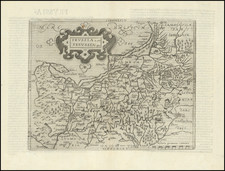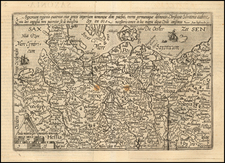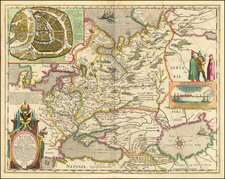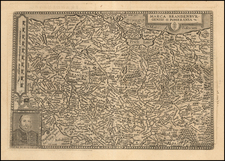Map showing the locations of German-run ghettos in Poland, published during a period in which the recognition of Jewish suffering in Poland was suppressed. Printed on the verso is a map of camps throughout Poland. These two maps were designed by Jan Laskowski and printed in 1979 as part of a work on the Nazi extermination machine produced by PWN Warsaw, a state-owned research-focused publishing house in Poland.
The map lists hundreds of ghettos run by Nazi operators throughout the country. These include concentration camps, death camps, transitional camps, and ghettos. The map is divided according to Poland's voivodeships, with a key in the lower left. Names of cities too long to spell are also provided in the lower left.
This map was produced during a point in Poland's history during which it was actively revisiting the period during the Second World War. Leading social scientists devoted their time to trying to gather all the living as well as the recorded history of the events of the Holocaust and related atrocities before this information vanished. Leading these efforts, particularly during the 1960s and 1970s, was the Główna Komisja Ścigania Zbrodni przeciwko Narodowi Polskiemu, known as the Chief Commission for the Prosecution of Crimes against the Polish Nation. They were active in publishing maps both for domestic educational purposes and for international remembrance and diplomatic efforts regarding the Holocaust. Jan Laskowski was a leading cartographer who produced a number of maps in this field.
This map was produced as part of a series of maps that purported to combine to form an atlas of all of Hitler's crimes in Poland. Many of the large wall maps produced during this period could only show a fraction of the crimes, or only the atrocities committed in one region. Thus, a series of maps was needed to show all the points necessary, which this present work contributes to.
Polish Reinterpretations of the Holocaust
Studying the effects of German occupation in Poland is a delicate subject. While it is certain that Poland suffered at least as badly as any other European nation during the Second World War, reinterpretations of the Holocaust in the country have also been used to satisfy nationalistic tendencies. It has become evident to Western observers in the last several years that there is a strong nationalist movement in Poland that seeks to place blame for the Holocaust solely on the shoulders of non-Polish actors, a movement originally fostered under Soviet rule. This movement has gone so far as to limit freedom of speech, criminalizing (with a three-year sentence) the suggestion that Poland or its citizens (in any form) participated in the murders committed by Nazis. As such, the term "Polish concentration camps" has been deemed unacceptable, with the government-approved term being "concentration camps on Polish territory."
All lines of evidence show that this map was produced using the most accurate and impartial historical sources. The language on the map is simple, naming only "Hitler's Atrocities," and there is no evidence of a clear anti-German bias. However, it is impossible to separate this map, one of the most important productions of the remembrance movement during this period, from the social situation in which it was produced. Maps like these can easily be converted into propaganda instruments, and today's Polish leaders, most of whom grew up during Soviet occupation, will have formed their understanding of the Holocaust through maps like these.
Soviet Censorship
While the content of the map appears to have been produced free from bias, the map still had to go through Soviet censorship. Mentioning prisoner of war camps, in which primarily Soviet troops were interned, would have been a prerequisite condition upon which the publication of the map rested. Further, the lack of mention of any Soviet killings or camps requires no explanation. In addition, the Warsaw Ghetto is not referred to at all, with only general symbols used around Warsaw.
The map, unlike many later maps, makes no differentiation between the populations who suffered at the various camps. This represents the Soviet agenda that all nations suffered, fought, and won equally, which sought to limit divisions in this post-identity state.











